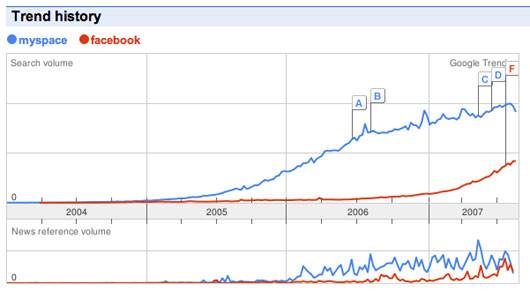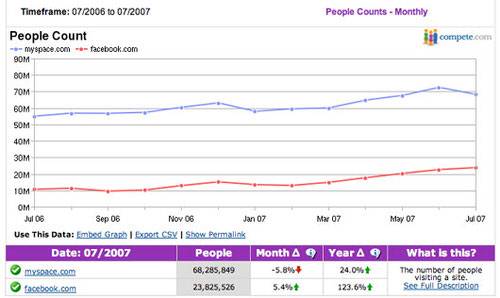MySpace is responsible for putting social networking on the map. Despite the site’s notoriously bad design
and poor navigation, millions of people flocked to it because it provided a simple, yet powerful
way to self-express and to connect with others online. It has now been more than 2 years since Rupert Murdoch’s News Corp. spent over half a billion dollars to acquire the social networking darling and the buzz is quieting down.
2007 has been the year of Facebook — another social network that is now
experiencing big growth and captured the attention of the media. Still other networks like Bebo, Hi5, and Google’s Orkut are also on the rise. So how is MySpace holding up?

It seems like MySpace is being digested.
Now that we have been spoiled by the elegance and recent innovation surrounding Facebook’s Platform, MySpace simply no longer
seems like such a big deal. Yes, it still has a lot of eyeballs due to its mammoth user base, but is it growing? Are people
sticking with it? And is News Corp. on the way toward recovering the money it spent to acquire the site? In this post we look at MySpace through the prism of the digestion phase to find out what’s going on and where it might be headed.
Trends and Charts
We’ll use Google Trends and traffic analysis from Compete to get a snapshot the latest statistics. First, in the diagram below
is a comparison of “myspace” and “facebook” as trends. Judging by the shapes of the curves, MySpace either
has peaked or is about to peak, while the Facebook trend is on the rise. Facebook appears ready to take over in news references, as well.

The charts from Compete also provide interesting insights. The first chart below shows that the
amount of time users spend on MySpace is roughly twice the amount they do on Facebook.

The next chart shows velocity, or relative growth, compared to other sites on the web. According to Compete:
“Velocity reports the relative change in daily Attention. Velocity is used to determine the relative growth of a domain over a particular timeframe or compared to other sites.”
The timespan here is the last 45 days, which is a bit misleading since August is traditionally
a month when a lot of people are on vacation. However, the decline is still fairly rapid.

Finally, the chart below shows the number of people visiting each site. Note the difference in the year-over-year rate of
growth at the bottom of the image. MySpace grew 25% this year, while Facebook grew 125%.

The Growth Slow Down: Is There A Problem?
Here are the conclusions that we can draw from these charts:
- MySpace as a trend is on the decline, while Facebook as a trend is on the rise
- MySpace is still growing, but not as rapidly as it once was
- Users still spend more time on MySpace than on Facebook
But even if growth at MySpace is slowing down it does not mean there is necessarily a problem.
Slowed growth can be due to many factors. First, it could be simply that the current number of users is approaching
the total market of people who would be interested in using MySpace (i.e., a saturation point). Facebook and other networks are
smaller, so this could also explain why they are growing faster. Just because
MySpace is a generic social network, it does not mean that it is for everyone. For example, professionals do not network on MySpace,
they use LinkedIn. Facebook has also fairly different audience; MySpace’s funky pages and user-controlled designs are just not for everyone.
So there is actually a finite number of people who are interested in using the site.
MySpace Users Are Very Active
Next, let’s take a look at random MySpace profiles to see how active they are. Personally, I find it mind boggling
that people can be looking at these ugly and disorganized pages, but there is no mistaking it: MySpace users
are very active. I sampled over 30 random profiles and close to 100% of them were active. Even people who
have only 15 or 20 friends have comments on their profiles. This implies that the users are using the site daily
to communicate.
MySpace profiles are also complete with interests, pictures, videos and music. Most pages start playing music or videos
as soon as you load them, which gives you an immediate taste of the owner’s personality, and people have certainly mastered the basics of skinning MySpace, as most profile pages are customized. Also, a lot of users are fluent in embedding videos and widgets, mostly from
YouTube.
MySpace – Sexy Time All The Time?
Yet despite a lot of things going on at MySpace, it feels like the site is often mostly about hooking up. Many of real
comments and spam are about dating and sex. Particularly, teenagers, singles, and folks who are after
them are openly provocative and inviting.
The problem goes beyond just people soliciting each other. The Associated Press recently reported
that close to 30,000 users of MySpace are sex offenders. This may not be an image that News Corp. wants (particularly
when we start talking about monetization), which is why more restrictions are coming.
Design, Platforms, Widgets: Does Any Of It Matter?
So what do we make of this? An active community that emphasizes sex, self-expression and has users who
post messages on each other’s profile pages instead of using email… How can this possibly be more interesting
or better than Facebook? Earlier this year, Facebook became more than a social network. It is now a platform, a piece of the web infrastructure designed
to host social applications. MySpace on the other hand offers little pluggability, has a history of fighting widget creators, and doesn’t offer much more than custom HTML/CSS templates.
But does any of that matter? It is ironic, but MySpace profiles (once you get used to them or take some Tylenol)
are simpler than those on Facebook. On a random Facebook profile you are presented with tens of applications that you
have not seen before (and likely do not care about). On MySpace you get pictures, music, videos and most importantly,
messages. Today MySpace is still fundamentally about communication, about connecting people. With Facebook
the basic communication, the messaging via the Wall, has been relegated to the background, overshadowed by everything else.
So it appears that MySpace users are quite fine without a platform — they like MySpace as is.
MySpace Monetization
This discussion wouldn’t be complete without talking about monetization, of course.
It’s wonderful that users use MySpace, but does it make money for News Corporation? Like any social
play, the main bet here is advertising. Given the fantastic number of users and page views this monetization avenue
is a no-brainer. A recent ad deal with Google alone justifies the cost of purchase, since Google
committed to almost $1B dollars in guaranteed revenue.
But it is not all that simple. As Donna Bogatin wrote in a sarcastic piece last year,
Google is actually doing MySpace a huge favor by committing guaranteed revenue. The questions that are far from settled are these:
Will users even click on these ads? Will they spend the money? Do they even have wallets? It is difficult not to be skeptical.
Conclusion
So is MySpace still hot? As a trend the answer is no, but as a site, yes. The level of user
activity is the single most important measure and it is clear that people are using MySpace. What they are doing there is a different question.
While a lot of people are using the site to keep in touch with friends, for many it appears to be a place to trawl for dates and sex.
Further, the MySpace crowd does not appear to be in big need of a platform and additional applications. They are
fine with basic messaging, simply as a way to replace email.
So what is the future for MySpace? A lot of it will depend on News Corp.’s ability to retain the audience.
If they can hang on to their 100M users, there is a huge business here (at least while advertisers are willing to play).
What will it take? On one hand the site is fine as is, since apparently people still love and use it. One can’t help
but think, however, that it needs to evolve and innovate, but this is more of a historical or gut feeling.
For a foreseeable future, MySpace should be fine. Not hot, but certainly far from over.

















